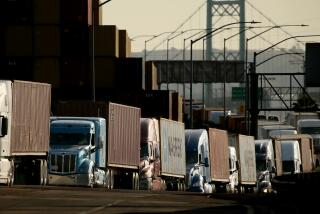Icebreakers Free Great Lakes Ships
- Share via
ABOARD THE U.S. COAST GUARD 6506 DOLPHIN — Helicopter pilot Robert Kornexl looked down in amazement Friday at the ice mosaic forming in the St. Clair River east of Detroit.
Icebreaking ships went through the river Thursday, “but you’d never know it,” the lieutenant junior grade told his copilot as their craft hovered 200 feet above the semi-frozen water.
Coast Guard icebreakers are busier than usual clearing paths for freighters on the Great Lakes and other waterways because of earlier-than-normal cold across the Midwest.
Last month, two freighters were stuck in the icy Detroit River at the mouth of Lake Erie for two days, causing a shipping traffic jam. Ten to 15 ships pass through the channel each day.
The last time Lake Superior froze over was 1994. It’s not that bad yet, but Lake Erie is almost completely iced over. Large portions of lakes Michigan and Huron are also frozen.
So is the St. Clair, a link between lakes Erie and Huron heavily used for commerce. On Friday, the 290-foot U.S. Coast Guard Mackinaw--the largest icebreaker on the Great Lakes--and the 140-foot Neah Bay sliced a slushy trail for about half a dozen freighters waiting to get through.
Ensign Scott Rae, operations officer on the 140-foot Bristol Bay cutter, said Coast Guard veterans are calling this year the worst for ice since 1976.
“When the ice first started forming, ships were caught by surprise,” he said.
Lake Carriers Assn. president George Ryan said the ice-filled waterways have affected iron ore, coal, salt and cement deliveries.
“If we did not have the U.S. and Canadian Coast Guards working together to direct this commerce, we would have serious economic consequences for the region,” Ryan said.
The Great Lakes waterways aren’t the only ones icing up. November was the nation’s second-coldest ever and December was the seventh-coldest, according to the National Climatic Data Center.
“Things are moving, but the ice is slowing things down,” said Paul Roszkowski, a Coast Guard spokesman in Cleveland.
“It’s important to keep shipping moving because it stimulates the economy,” he said. “Anything that can be shipped by water is shipped on the Great Lakes. We have to keep that moving as long as we can.”
Temperatures aren’t expected to warm up much: The National Weather Service predicted more below-normal temperatures in January, February and March in the Great Lakes region.
That’s good news for ice fishermen, who are under close watch as the Dolphin helicopter crew maps the ice from above. In Lake St. Clair’s Anchor Bay, the fishermen drive their trucks a half-mile out onto ice 1 1/2- to 2 feet thick.
“We could probably land this helicopter on it,” pilot Eric Hollinger said.
Come spring, the Coast Guard will have other duties. The heavy snow and ice are expected to raise water levels and could cause flooding.
On the Net:
U.S. Coast Guard https://www.uscg.mil
Lake Carriers Assn. https://www.lcaships.com
National Weather Service https://iwin.nws.noaa.gov
More to Read
Sign up for Essential California
The most important California stories and recommendations in your inbox every morning.
You may occasionally receive promotional content from the Los Angeles Times.













